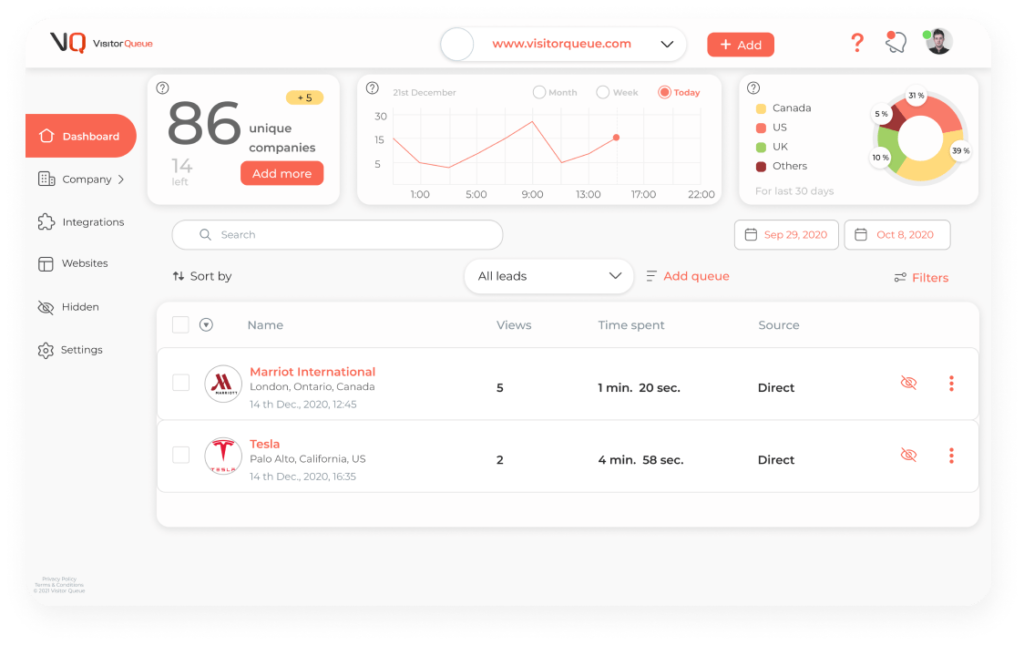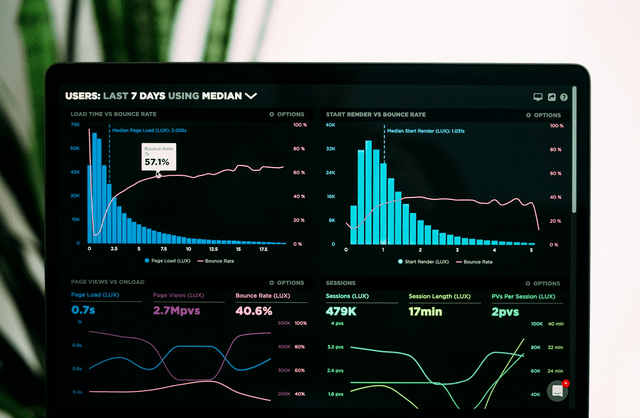Measuring website traffic is crucial in understanding visitor behavior, optimizing for user experience, and making data-driven decisions that can help your company grow. For B2B companies specifically, sales cycles are typically long, so, it’s important to ensure your visitors find what they are looking for on your website. In this article, we’re going to go through essential website metrics to track and the software to help you get more insight. First, let’s go over the importance of measuring your website traffic.
The Importance of Measuring Your Website Traffic
Having a lot of website traffic may seem good, but there is a lot more that goes into properly measuring traffic than just visitors. Here are some of the reasons why you need to properly measure your website traffic.
Understanding Your Online Presence
A company’s website is often the primary point of contact between a business and its potential clients. For B2B companies, establishing a strong online presence is critical because decision-makers often begin their research online. By accurately measuring website traffic, you can gauge your brand’s visibility and determine whether your digital marketing efforts are successfully drawing in the right audience. Traffic data provides a quantitative foundation for assessing the effectiveness of your marketing channels and helps you understand where to invest your resources. For example, if you have a large number of visitors acquired from Google Ads, but they are leaving faster than any other channel, then your ads may not be targeting the right audience.
Data-Driven Decisions
Measuring website traffic allows you to identify which pages are performing well and which need improvement. For example, if your analytics show that a particular landing page has a high bounce rate, you know it may need a redesign or more engaging content. On the other hand, pages with high engagement may signal that your content strategy is resonating with your target audience.
Improved Lead Generation and Conversion
Not all website visitors are created equal. By measuring metrics like unique visitors, session duration, and conversion rates, you can determine the quality of your traffic. And, high-quality traffic tends to engage more with content and is more likely to convert into leads or paying customers. Ensure that you include CTAs like eBook callouts in relevant blogs to keep your audience engaged for longer. Now that you know how important it is to measure your website traffic, let’s go over some of the key metrics you’ll need to consider.

Key Metrics for Website Traffic
There are a number of different metrics that you can track when it comes to your website traffic. Here are some of the most important ones to help you optimize your site and marketing strategies.
Unique Visitors and Sessions
Understanding the number of unique visitors, or users, is crucial because it tells you how many individual people are reaching your site. A user might visit your website several times, and each visit is recorded as a session. Monitoring both unique visitors and sessions provides insight into overall reach and repeat engagement. For example, a rising number of sessions per user can indicate strong interest and repeat engagement. As a result, this can suggest that visitors find your content valuable.
Pageviews and Pages Per Session
Pageviews reflect the total number of pages loaded or viewed, and they offer a simple measure of how much content is being consumed. However, the average number of pages per session is a more refined metric that indicates how deeply visitors are exploring your site. If visitors view multiple pages in a single session, this generally signifies effective content engagement and a well-structured website that encourages further exploration.
Bounce Rate and Engagement Rate
Bounce rate measures the percentage of visitors who leave your site after viewing only one page. A high bounce rate may suggest that your landing pages are not engaging or relevant enough. On the other hand, engagement rate is the percentage of visitors who interact with your site through clicking links, watching videos, or filling out forms. These are complimentary metrics that provide information about the quality of your traffic.
Traffic Sources
Knowing where your visitors come from is one of the most important metrics to track. Whether visitors arrive via organic search, paid advertising, referrals, social media, or direct entry can significantly influence how you tailor your marketing efforts. By tracking traffic sources, you can allocate resources more effectively, optimize your marketing channels, and understand which sources deliver the highest-quality leads. In addition, you can compare traffic sources to other metrics mentioned above. For example, if your leads acquired by organic search only view one page and then bounce, you’ll need to work on a strategy to add in supporting content on landing pages and blogs. Plus, this will keep organic visitors on your site by browsing and continuing their learning path.
Conversion Metrics
Ultimately, the goal of measuring your website traffic is to understand and improve conversions. Conversions for B2B companies may include form submissions, newsletter sign-ups, content downloads, or booked meetings. By tracking conversion rates, you can assess the effectiveness of your CTAs. And, determine which elements of your website are driving desired outcomes.
Software to Help Measure Your Website Traffic
Now, you’re probably wondering how to get started and track all of these website metrics. Let’s go over the best website analytics software to help.
Google Analytics
Google Analytics, or GA4, is easily the most popular software to help measure your website traffic. GA4 is built on an event-based data model, allowing for a more detailed understanding of user interactions. It tracks not only pageviews but also various events such as clicks, scrolls, and video views. GA4 also supports cross-platform tracking, making it ideal for businesses with both websites and mobile apps. It also integrated with other Google software like Google Ads and Google Search Console to help your marketing even further.
Hotjar
Hotjar offers a qualitative complement to quantitative analytics by providing visual insights into user behavior. It captures heatmaps, session recordings, and feedback through on-site surveys, enabling you to see exactly where users click, how far they scroll, and where they may be getting stuck. These insights are critical when looking to improve user experience and conversion rates. Hotjar is particularly useful for identifying usability issues and testing different design elements. Without the need to rely solely on numerical data like bounce rates.
Visitor Queue
Visitor Queue is the next website analytics tool on our list. It is best if you’re looking to tie website traffic with your lead generation efforts. Visitor Queue works to identify your website visitors, along with visit information like page views, time on page, and acquisition. Additionally, we provide employee contact information for the companies that visit your site. Our new Website Analytics Benchmarking feature can help you see how your website measures up to competitors in your industry. Plus, you can try Visitor Queue for free today to learn more about your website and its visitors.

Adobe Analytics
Adobe Analytics is geared toward enterprises that require advanced customization and data segmentation. It offers flexible tracking of complex user journeys and integrating data from multiple sources. Adobe Analytics enables detailed reporting and real-time analysis, allowing businesses to tailor their marketing strategies with precision. Although it comes with a higher price tag, its advanced features and integration capabilities make it a favorite among companies with advanced analytics needs.
Other Tools and Integrations to Consider
In addition to the tools mentioned above, many companies use a combination of specialized solutions to gain a full picture of their website performance. SEO platforms like SEMrush, Ahrefs, and Moz provide insights into keyword performance, backlink profiles, and competitor analysis. Which are all critical for optimizing organic traffic. Marketing automation platforms like HubSpot integrate website analytics with lead management and customer relationship management. This enables a seamless flow of data across marketing and sales teams. Additionally, these integrations ensure that all aspects of the customer journey are tracked and analyzed for continuous improvement.
Getting the Most Out of Your Data and Analytics
Now that you know what to track, and how to track, let’s go over a few strategies to help you get the most out of all of this new information.
Combine Quantitative and Qualitative Data
The most powerful insights come from combining quantitative data from analytics platforms with qualitative feedback from tools like Hotjar. Quantitative metrics, like session duration, bounce rate, and conversion rates, provide a numerical overview of website performance. Qualitative data, such as heatmaps and session recordings, help explain the “why” behind these numbers. For example, a high bounce rate might be explained by a poorly designed landing page that fails to engage visitors, a theory you can test with session recordings.
Integrating With Your CRM
Integrating website analytics with your CRM and marketing automation systems allows you to link visitor behavior directly to lead quality and sales outcomes. By aligning this data, you can monitor your entire customer journey. From the initial website visit to the point of conversion. Additionally, this can help align your sales and marketing teams, ensuring that leads are properly handed off between the two.
Create Custom Dashboards
Try to create custom dashboards tailored to your specific business goals is critical for ongoing success. Custom dashboards allow you to monitor metrics in real time. This enables you to react quickly to any changes in user behavior. Tools like GA4 and Adobe Analytics offer flexible reporting options that let you visualize data in the way that makes the most sense for your business.
How to Improve Your Website Traffic
Improving your website traffic can be achieved by focusing on high-quality content, strategic SEO, and multi-channel promotion. Start by regularly publishing engaging, in-depth articles that answer your audience’s specific questions. Optimize your site for search engines with proper keyword targeting, faster load times, and a mobile-friendly design. In addition, leverage social media and targeted email campaigns to drive qualified traffic. It can take time to increase and measure your website traffic, so ensure that you stay consistent. Take a look at our article, 11 Ways to Increase Website Traffic, to learn more.
Wrap Up
We all know that measuring and analyzing website traffic is essential if you’re looking to improve your marketing strategies. By tracking your key metrics, using analytics tools, and implementing data-driven strategies, your company has a better chance of improving its conversion rate and closing more deals. If you have any questions about using Visitor Queue to measure your website traffic, do not hesitate to reach out.
 Identify
Identify Personalize
Personalize Benchmark
Benchmark Agencies
Agencies Integrations
Integrations Case Studies
Case Studies Use Cases
Use Cases Blog
Blog Resources
Resources









